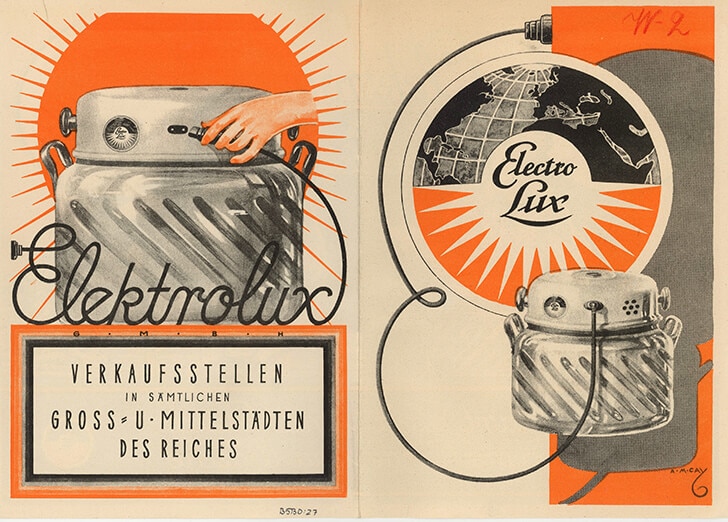Many changes took place in society after World War 2, but few were more remarkable than the arrival of the domestic washing machine which was to radically change the lives of many families.
A process of experimentation
Some game-changing innovations come as a surprise. Until you start to use one, you had no idea how much you needed it. Not so the washing machine. This was something that several generations of inventors had worked towards, well aware of the need for a device that would relieve the arduous drudgery of washday. This wondrous machine did not come out of nowhere.
James King in 1851 created the first washing machine to use a drum, Hamilton Smith in 1858 patented a rotary version, and in 1868 Thomas Bradford, a British inventor, created a commercially successful machine that resembles the modern device. William Blackstone of Indiana created one as birthday present for his wife in 1874 and then put it on the market.

Advert for early manual washingmachine from Electrolux in Germany
All ingenious and effective but lacking in power. Electricity combined with running water was to be the great gamechanger, but not without some teething troubles. The first electric machines had a motor under a bowl full of water. Needless to say in the early days there were many shocks.
The first Electrolux model was a large kettle that could be put on the stove to heat the water, A roller, which was in the lid and powered by an electric motor, rotated and pressed the laundry against the flared side of the kettle.
Riverside, rural wash
In the meantime, women were going down to the lake, river or outdoor laundry to get the washing done. It was a sociable event and these wash sessions were the predecessors of laundrettes and laundry rooms. But the days were long and the work was back-breaking and could take several days. People had more clothes and did not change garments or wash so often. only twice a year!
Lye was used to get the clothes clean which was preferable to urine which had been used by the Romans! Tools were available. The washboard was an invaluable device and perhaps originated from Scandinavia. The mangle was another breakthrough but was not kind to buttons nor fingers or hair.
Urban washing arrives
With the growth of larger cities, special buildings or communal washing places by the river were created for doing the wash. A new service industry arose: the washer woman who took in large amounts of washing from households, hotels etc.
Some major changes were imminent. Washing machines, like many other kitchen appliances, became more widely available in the period following the Second World War. However one of the very first “tvättstugas” (cost-free, communal laundries) was built in Stockholm in the 1920s. In the decades that followed, it became more and more common for such a laundry to be included in the design when a new apartment block was built. In 1944, Electrolux acquired Bohus Mekaniska Verkstad and thus entered the market for industrial washing machines. In1950, eight per cent of Swedish households had access to a communal laundry.
The renowned Swedish medical doctor, academic and public speaker Professor Hans Rosling has made the case that the washing machine was the greatest invention of the industrial revolution for the way it enabled women to turn a boring wash day into a day of reading.

